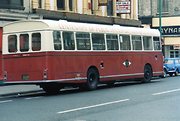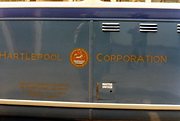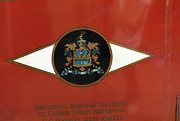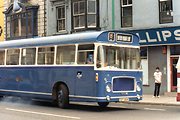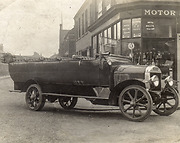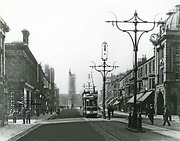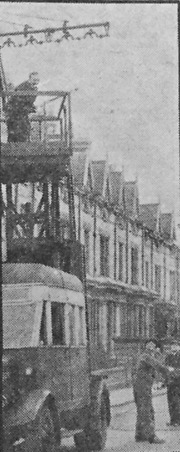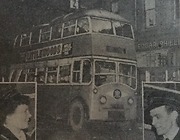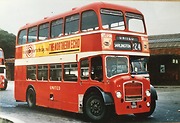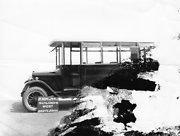 Hartlepool Sports & Leisure
Hartlepool Sports & Leisure
- Cinemas, Theatres & Dance Halls
- Musicians & Bands
- At the Seaside
- Parks & Gardens
- Caravans & Camping
- Sport
 Hartlepool Transport
Hartlepool Transport
- Airfields & Aircraft
- Railways
- Buses & Commercial Vehicles
- Cars & Motorbikes
- The Ferry
- Horse drawn vehicles
 A Potted History Of Hartlepool
A Potted History Of Hartlepool
- Unidentified images
- Sources of information
- Archaeology & Ancient History
- Local Government
- Printed Notices & Papers
- Aerial Photographs
- Events, Visitors & VIPs
 Hartlepool Trade & Industry
Hartlepool Trade & Industry
- Trade Fairs
- Local businesses
- Iron & Steel
- Shops & Shopping
- Fishing industry
- Farming & Rural Landscape
- Pubs, Clubs & Hotels
 Hartlepool Health & Education
Hartlepool Health & Education
- Schools & Colleges
- Hospitals & Workhouses
- Public Health & Utilities
- Ambulance Service
- Police Services
- Fire Services
 Hartlepool People
Hartlepool People
 Hartlepool Places
Hartlepool Places
 Hartlepool at War
Hartlepool at War
 Hartlepool Ships & Shipping
Hartlepool Ships & Shipping

Buses
Details about Buses
Images relating to buses, coaches and other passenger vehicles in Hartlepool and the surrounding area.
Location
Related items () :
 1930s Special - Passing "Old Boys" Field.
1930s Special - Passing "Old Boys" Field.
 Created by unknown
Donated by Hartlepool Library Service
Created by unknown
Donated by Hartlepool Library ServiceThis 'Special' bus passing the Old Boy's Field (on the right), on Cleveland Road, is not painted but has an etched and polished aluminium skin.
HHt&N 633
More detail » Accident between a bus and fire engine
Accident between a bus and fire engine
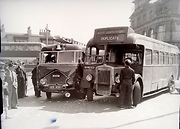 Created by NDM
Donated by Hartlepool Museum Service
Created by NDM
Donated by Hartlepool Museum ServiceDated 1955
On 30th May 1955, a fire engine which was on the way to a grass fire on the Headland, collided with a United bus at the Church Square and Stockton Street junction. The bus had come down Hart Road(now Raby Road) and was travelling to the United Bus Station. Binns store can be seen on the right behind the bus.
Another fire engine was sent to the fire and the accident took half an hour to clear, attracting a lot of onlookers at the busy juntion.
More detail » Accident in the fog
Accident in the fog
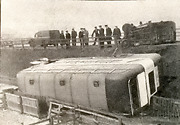 Created by NDM
Donated by Hartlepool Museum Service
Created by NDM
Donated by Hartlepool Museum ServiceDated 1953
This West Hartlepool Corporation bus was travelling from the town along the Tees Road to Port Clarence when, in very thick fog, the driver had to swerve to avoid a van near Graythorp. Amazingly there were only 6 minor casualties who were taken to Cameron Hospital West Hartlepool.
The driver, Robert Hughes,44, of Thirsk Grove said he was lucky to be alive and when he swerved in bad visibility, the bus toppled over.
More detail » Binns 1992
Binns 1992
 Donated by Hartlepool Library Service
Donated by Hartlepool Library ServicePart of the Library collection collection
Dated 1992
Shortly after the store was closed in 1992, it is for sale but the signage had not been removed. The number 7 bus shows the Hartlepool Corporation livery rather than the Stagecoach livery seen in most towns today.
HHT&N 896
More detail » Brierton trip to Easby Abbey 2
Brierton trip to Easby Abbey 2
 Donated by Terry Musgrave
Donated by Terry MusgraveTaken around 1964 on a trip to Easby Abbey near Richmond. Terry Musgrave is the boy on the left.
More detail » Bus Drivers and Ticket Collectors
Bus Drivers and Ticket Collectors
 Donated by John Parsons
Donated by John ParsonsBus Drivers and Ticket Collectors outside the depot.
More detail » Bus Timetable 1957 Suez Crisis
Bus Timetable 1957 Suez Crisis
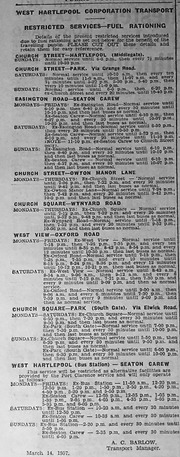 Created by NDM
Donated by Hartlepool Museum Service
Created by NDM
Donated by Hartlepool Museum ServiceDated 1957
In March 1957 a restricted bus timetable was introduced by West Hartlepool Corporation Transport during the Suez Fuel Crisis.
More detail » Bus Wash
Bus Wash
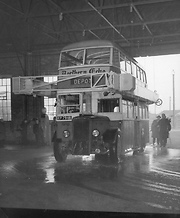 Created by NDM
Donated by Hartlepool Museum Service
Created by NDM
Donated by Hartlepool Museum ServiceHere a West Hartlepool corporation bus is being washed probably at Greenland bus depot in the early 1950s.
More detail » Bus driver and conductor uniform badges
Bus driver and conductor uniform badges
 Donated by Hartlepool Museum Service
Donated by Hartlepool Museum ServiceHere are examples of badges for Hartlepool Corporation Transport and West Hartlepool Corporation Transport on the right. It is unclear whether the Hartlepool badges are from the old borough or from the new amalgamated Hartlepool after 1967.
More detail » Bus tickets 1940s
Bus tickets 1940s
 Donated by Hartlepool Museum Service
Donated by Hartlepool Museum ServiceBefore the ticket issue machines were introduced in the late 1940s, a conductor had to carry a collection of different tickets which had to be hand punched. There were quite a few permutations and prices for children, single tickets, return tickets and also two journey tickets as seen here.The numbers down the long sides of the ticket denote the fare stages on a journey and the conductor had to punch the relevant number where the passenger boarded.
Fare stages were about every second or third stop.
More detail » Buses in Raby Road
Buses in Raby Road
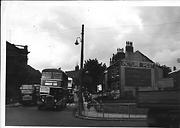 Part of the Library collection
Part of the Library collectionTaken in the 1950s, the Wesley can be seen on the left and the Northern Daily Mail Office on the far right. The area on the right has been completely demolished and rebuilt. Behind the buses, the roof of the Town Hall can be seen.
Somebody with a knowledge of buses, has inscribed on the reverse of the image: Left is a United Bristol single deck bus service 40 to Sunderland. The first double decker is a United Bristol service 40A from Easington Village and Peterlee. THe bus at the rear is a Sunderland District Leyland service 40 from Sunderland.
This was in the days when there was a very thriving bus station which was constantly full of buses wearing the livery of many different North East companies. it stood where the 'transport interchange' can now be found close to the Marina Bridge.
Information from Stephen Young states that the building on the right of the image with Public Post on the gable end was the Peal Assurance House.
More detail » Centenary of Public Transport, Hartlepool
Centenary of Public Transport, Hartlepool
Pictures of Buses in old liveries to celebrate the centenary of public transport in Hartlepool 1884 - 1984.
More detail » Charabanc Outing
Charabanc Outing
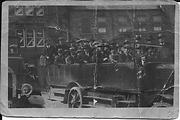 Donated by Anne Cox
Donated by Anne CoxA group of people on a charabanc outing from Hartlepool. Where To ? There is an advert for the Yorkshire Herald on the building behind the vehicle.
More detail » Charabanc outing
Charabanc outing
 Donated by Hartlepool Library Service
Donated by Hartlepool Library ServiceThis North Eastern Railway charabanc has a full load of passengers, presumably for an outing. Most of the gentlemen passengers appear to be wearing flowers in their buttonholes. Note too, the chain-driven rear wheels.
HHT&N 635
More detail » Civil Defence Mobile Canteen
Civil Defence Mobile Canteen
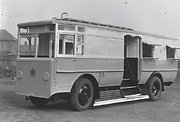 Donated by Douglas Ferriday
Donated by Douglas FerridayPart of the Hartlepool Library Service collection
A West Hartlepool Corporation Mobile Canteen for use by the Civil Defence. This photograph was probably taken during the Second World War, as the running boards and leading edges of the interior steps have been painted white. Although the body looks grey, it was in fact painted pale blue and cream. As this is a converted trolley bus with no power poles, it had to be towed to wherever it was needed.
More detail » Decorated Trolley Bus (1)
Decorated Trolley Bus (1)
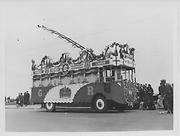 Donated by Hartlepool Library Service
Donated by Hartlepool Library ServicePicture taken at Seaton Carew on 18th May 1937. Bus decorated to mark West Hartlepool Corporation Jubilee Celebrations. This also coincided with the coronation of King George VI in 1937.
hht&n 1079
More detail » Decorated Trolley Bus (2)
Decorated Trolley Bus (2)
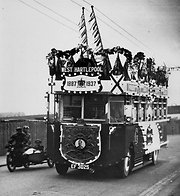 Created by unknown
Donated by Hartlepool Library Service
Created by unknown
Donated by Hartlepool Library ServiceDated 1937
A very ornately decorated trolley bus on the aptly named Coronation Drive, celebrating the 1937 Coronation and also the County Borough of West Hartlepool's 50th Anniversary.
More detail » Electric Tram Office 1970
Electric Tram Office 1970
 Donated by Douglas Ferriday
Donated by Douglas FerridayPart of the Hartlepool Library Services collection
Dated 1970
This a clear image of the Electric Tram Office taken in 1970.
More detail » Elwick Residents on day out
Elwick Residents on day out
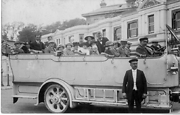 Donated by Hartlepool Museum Service
Donated by Hartlepool Museum ServicePart of the Sample bequest collection
A group of Elwick residents pose in a charabanc in front of Richmond Chambers.
More detail » Elwick Residents on day out (2)
Elwick Residents on day out (2)
 Donated by Hartlepool Museum Service
Donated by Hartlepool Museum ServicePart of the Sample bequest collection
Elwick residents pose in a charabac in an unknown location.
More detail » End of the trolley
End of the trolley
The last trolley bus left Church Street for the Headland at 11.00 pm on Thursday April 2nd 1953 and was full for that memorable trip. The driver was Frank Burgon and the conductress Eileen Dixon.
By April 6th, council workmen were dismantling the overhead lines in Grange Road.
More detail » First electric tram in Hartlepool - 1896
First electric tram in Hartlepool - 1896
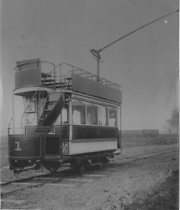 Donated by Hartlepool Museum Service
Donated by Hartlepool Museum ServiceDated 1896
Tram No. 1 began service on 19 May 1896
More detail » Fleet Review
Fleet Review
 Created by unknown
Donated by Hartlepool Library Service
Created by unknown
Donated by Hartlepool Library ServiceDated 1939
The brand new fleet of West Hartlepool Corporation trolley buses lined up outside the Greenland Road Depot in 1939.
More detail » G and B bus
G and B bus
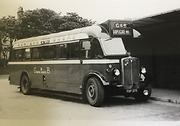 Created by East Pennine Transport Group
Created by East Pennine Transport Group
Taken in the bus station, this is a G and B Motor Services bus belonging to the Gillett brothers and Joseph Baker who had both begun services in 1923. In 1926, a service between Thornley, Wheatley Hill and Hartlepool was begun, the two companies amalgamating into G and B and then extending the route to Durham. In 1928 they added a service to Bishop Auckland from West Hartlepool.
The Baker family sold out to the Gilletts in 1959 but the public always referred to the buses as G and B. In 1974 after the death of the two Gillett brothers, the company was sold to United.
The image is probably taken in the late 1950s and the livery was dark brown and cream.
More detail » G. Waugh Ltd., Raby Road
G. Waugh Ltd., Raby Road
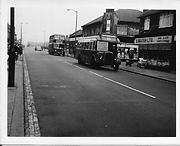 Donated by Hartlepool Library Service
Donated by Hartlepool Library ServicePart of the Library collection collection
Looking north up Raby Road, G. Waugh is on the right. Two United buses are clearly making their way into the centre of West Hartlepool. The photo will have been taken in the early 1960s.
HHT+N 828
More detail » Garrett Trolleybus No.25 in West Hartlepool livery
Garrett Trolleybus No.25 in West Hartlepool livery
 Donated by Long Shop Museum
Donated by Long Shop MuseumRichard Garrett & Sons sold 12 units to West Hartlepool Corporation, works Nos. 312-323 between 29.01.1927 & 15.03.1927.
Richard Garrett & Sons was based in Leiston, Suffolk.
This image is protected by copyright. Do not reproduce in any format without the permission of Long Shop Museum, Leiston, United Kingdom.
More detail » Gillett Brothers bus
Gillett Brothers bus
 Dated 1963
Dated 1963Taken in 1963, this is a Gillett Brothers bus which would still have been called G and B by the public. SEE G and B bus on this page.
The destination board says, amongst other places, Bishop Auckland, Wingate, Wheatley Hill, South Church and Spennymoor.
The livery was brown and cream.
More detail » Grange Trip
Grange Trip
 Donated by Frances Wilson
Donated by Frances WilsonDated 1963
Taken in the early 1960s, the Beeline bus sign says Torquay but it is an unlikely destination for so many buses from a school. The headmaster, Sid Rawlings can be seen surrounded by female staff wearing their 'pac a macs' which were a must in the 1960s on potentially rainy school trips ! The teacher looking towards the camera is Miss Lilian Watchman. Probably a trip to the Roman Wall indicated on another photo.
More detail » Greenland Bus Depot 1928
Greenland Bus Depot 1928
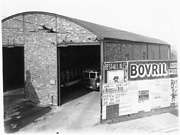 Donated by Douglas Ferriday
Donated by Douglas FerridayPart of the Hartlepool Library Services collection
Dated 1928
Greenland Bus Depot 1928. This photograph shows the front of a Hartlepool single decker bus in the depot. The Registration No. is EF 3358. The side wall has advertising hoardings.
More detail » HCT Blue Bus at terminus
HCT Blue Bus at terminus
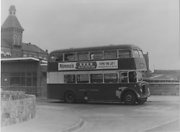 Donated by Hartlepool Museum Service
Donated by Hartlepool Museum ServiceHCT bus at terminus with the Borough Hall in the background. Probably mid 1960s
More detail » Hartlepool Transport Ltd.
Hartlepool Transport Ltd.
Hartlepool Transport Ltd. and its predecessors, 1884-1994.
Compiled by John Watson.
For many years in the 19th century the only form of regular public transport in the Hartlepools was provided by the North Eastern Railway Company between the two towns, but this could not cater for intermediate traffic, and with the development of Central Estate and other housing areas there was increasing scope for a road-based transport system. Such a system came into being on 2 August 1884 when the Hartlepools Steam Tramways Co. Ltd. opened a line of 3ft 6in gauge from Church Street, West Hartlepool, to Northgate, Hartlepool. The rolling stock, built by Falcon of Loughborough, consisted of 52-seat double-deck top-covered trailer cars, each on two bogies, drawn by small box-like steam locomotives. A small depot was erected at the junction of Cleveland Road and Hart Road, Hartlepool. For the return journey the locomotive would first be transferred to the other end of the car by means of a passing loop in the track. Altogether six locomotives and five trailer cars appear to have been operated at various times. The livery of the fleet is not known.
The steam tramway last operated on 21 February 1891, the company by then being in the hands of a receiver, Joseph Ebbsmith. This gentleman was instrumental in the setting up of a company in Wolverhampton, eventually to become the Electric Construction Company, for the manufacture of electrical machinery. This company took over the derelict Hartlepools line, re-laid it, and added overhead electric wiring supported by poles. The service re-opened on 19th May 1896. Electric car No.1, was one of five 44-seat four-wheelers built by Milnes of Birkenhead for the new operating company, the General Electric Tramways Co. Ltd. (GET). The livery is thought to have been green and white. Like all later double-deckers on the Hartlepools tramways the cars were open-topped to give sufficient clearance for the overhead trolleys under two railway bridges on the route. The opening took place at noon on a Tuesday, and evidently coincided with school dinner hour. Two more cars of the same design, Nos. 8 and 9, were obtained in 1897. The new system included a depot and electric power station at Greenland, on the West Hartlepool side of the inter-town boundary.
By the end of 1897 the electric tramcar fleet had doubled in size. The latest car, No. 10, could seat 62 people, and was a longer version of the previous cars, with the body carried on two four-wheel bogies. The end of the car is fitted with a buffer and chains, for the attachment of a trailer. The other cars were similarly equipped, and two trailer cars, numbered 6 and 7, had been purchased earlier in 1897 for use at peak times, but no photographs of them have come to light.
In 1895 another company, the British Electric Traction Co. Ltd. (BET), had ambitions on a national scale, largely to be realised, and obtained powers to construct two new lines in West Hartlepool, to the Park and to Foggy Furze. These opened on 10 March 1899, and were operated by a new BET subsidiary, the inaccurately named Hartlepool Electric Tramways Co. Ltd. (HET). The cars were painted in the current standard BET livery of orange-yellow and white. Soon after its start of service the HET took over the operation of the GET system and its cars, and repainted them into the BET livery.
In 1901 the HET acquired four more four-wheeled cars, this time built by the Electric Railway and Tramway Carriage Works (ERTCW) of Preston and seating 45. Two Brush 65-seat bogie cars with reversed staircases were bought by the HET in 1901, numbered 20 and 21. On 28 March 1902 the HET opened a fourth electric line, to Seaton Carew, with much of the track laid on the sea banks alongside the road. Four ERTCW 70-seat bogie cars with reversed staircases were purchased for the service, although as it turned out they would be used mainly on the Hartlepool line. The enclosed platforms of these four cars were a welcome innovation, especially from the point of view of the drivers.
A remarkable development in 1904 was the construction by the HET’s own workshop staff of a unique pair of cars. Each incorporated the Milnes bodies of two of cars 1-4 of 1896, joined together and mounted on new bogies. With an overall length of 38ft and 84 seats these cars are thought to have been the largest to have operated on a British 3ft 6in gauge tramway. The two cars were numbered 8 and 9; the original cars having these numbers were renumbered 6 and 7 in about 1902, after the trailers carrying these numbers had been disposed of. Like other tramway operators, the HET needed a tower wagon to permit work on the overhead wiring and a horse was stabled at the Greenland depot to draw the tower wagon and for other purposes.
On 31 August 1912, after lengthy negotiations with the HET, ownership and operation of the local tramways were transferred to West Hartlepool Corporation, except in two respects. First, because of inconsistencies in the local legislation, the Park and Foggy Furze lines and seven cars had already been purchased by the corporation on 25 September 1911 although the company had continued to operate them. The total fleet comprised 21 cars, the number transferred in 1912 therefore being 14. Second, the track and overhead in Hartlepool remained in the ownership of the GET, now leased to West Hartlepool Corporation in succession to the HET. The corporation’s first new cars, numbered 1-5, were purchased in 1914, 58-seat four-wheelers built by United Electric. The corporation’s livery was a brownish dark red and white, possibly inherited from the HET: the BET standard had become such a combination on several systems, replacing the orange-yellow of a decade earlier.
West Hartlepool Corporation purchased six more cars in 1920 to replace some of the original cars on the system, which had been worked hard during the war. The new cars were Brush 70-seaters on bogies and numbered 27-32. The Corporation also purchased five AEC 32-seat single-deck motor buses with solid tyres, the intention being to run a service from Seaton Carew tram terminus to the Middlesbrough Transporter Bridge at Port Clarence, a distance of six miles along the recently opened Tees Road. The service was to be jointly operated with Middlesbrough Corporation, which was unable to start operation until 4 April 1921, so West Hartlepool meanwhile ran a short-lived circular service within the town, starting on 17 July 1920. Middlesbrough Corporation withdrew from the Tees Road route in 1927, by which time West Hartlepool’s buses were operating to and from Church Street, for through passengers only.
In 1923 the corporation bought two 66-seat tramcar bodies from English Electric and mounted them on the bogies of the 1904 rebuilds 8 and 9, whose numbers they took up. As it was to turn out these new bodies would remain in service for only four years.
In common with many other small tramway systems, West Hartlepool Corporation decided in the 1920s to convert its tram routes to trolleybus operation. The trolleybus was a hybrid vehicle, with rubber-tyred wheels and two trolley arms in continuous contact with a pair of overhead wires. The cost of future track repairs and renewals was thus avoided, while at the same time the existing electricity generating equipment could be retained for further service. The Foggy Furze route was the first to receive trolleybuses, on 28 February 1924, with an extension of about half a mile to a point near the Traveller’s Rest Hotel.
(It should be noted that the corporation numbered its trams, motor buses, and trolleybuses in three separate series, each starting at 1.)
In 1925 the motor bus fleet was expanded by the addition of four Bristol 2-ton vehicles with Bristol 24-seat bodies. There are no known photographs of these buses, but No. 10 (EF 2810) was converted to a tower wagon in 1929. The Park tram route was the next to be converted to trolleybus operation: the service started on 3 February 1926. Two more Railless/Short Brothers single-deckers entered service, differing from the previous four in having doors at the centre instead of at the front. A third vehicle obtained for the Park trolleybus conversion was a Railless/Short Brothers 48-seat open-top double-deck body, No. 7 (EF 3027), however, this vehicle proved to be unsatisfactory, already being of obsolete design when new, and last ran in 1928. Two Bristol 4-ton vehicles with Bristol 30-seat bodies were added to the motor bus fleet in 1926, with pneumatic tyres becoming standard by this time for all but the largest vehicles.
The Hartlepool tram route was converted to trolleybus operation on 23 February 1927, but only after protracted disagreement between the two corporations. Hartlepool had purchased the track and overhead wiring in its area from the GET on 2 August 1925, and obtained powers to operate motor buses. West Hartlepool naturally proposed to use trolleybuses, and Hartlepool was eventually obliged to agree to this type of vehicle. Hartlepool paid for the new overhead equipment in its area, and the trolleybuses were a special batch in the joint ownership of the two corporations and bearing the two insignia. For the purposes of management and operation the new fleet was treated as a part of the West Hartlepool undertaking. The use of pneumatic tyres was a novelty on vehicles of this size. The new service operated a one-way loop in Hartlepool, with a terminus near St Hilda’s Church about 300 yards beyond the former tram terminus in Northgate.
Trolleybuses took over from the trams on the Seaton Carew route on 26 March 1927, completing the conversion programme. In the centre of West Hartlepool the route now followed a loop via Lynn Street, Church Street and Whitby Street, instead of the northern part of Mainsforth Terrace. Twelve Garrett vehicles with Roe 32-seat bodies, of similar appearance to the special fleet for the Hartlepool route, were placed in service. The large number enabled the more primitive vehicles obtained in 1924 and 1926 to be restricted to duplication duties.
More motor bus services were started in the late 1920s, notably from Rift House to Thornhill Gardens via the centre of West Hartlepool. At this time these services were largely one-man operated. In 1927 seven Bristol B vehicles with Roe 29-seat two-door bodies entered service, taking the numbers 1, 4-6, and 11-13 (EF 3461/4-6/71-3). The main panels of these vehicles were of aluminium, unpainted and buffed to produce an attractive striped effect. Four similar buses, but with front entrances only and 31 seats, were obtained in 1928, numbered 14-17 (EF 3714-7), but no photographs of them have been discovered. The striped effect was also applied to the corporation’s first double-deck motor buses, two Daimlers with Hoyal 48-seat bodies placed in service in 1931. By this time one-man operation of full-size single-deckers was no longer permitted, so it became more economical to operate double-deckers.
A new livery of Royal Dominion red and cream was introduced in 1934 for the entire fleet, the striped livery having been found troublesome when panels became damaged. The red was lighter than the previous shade, although often rather inaccurately described as maroon. Roe-bodied Daimlers 7 and 10 (EF 5387 and 5390) were the first to be delivered in the new colours. During the war, the headlights were hooded and the mudguards edged in white paint to permit operation in black-out conditions, and bus roofs were now painted grey instead of cream to reduce visibility from above. Two Bristol J types with Bristol 36-seat single-deck bodies were purchased in 1935.
From 1936 onwards all West Hartlepool Corporation Transport motor buses except two were fitted with Diesel engines. The first two, Nos. 2 and 3 (EF 5892-3), were of the same appearance as the 1934 vehicles numbered 7 and 10, but no photographs are known. The first 1937 vehicle, No. 1 (EF 6321), was one of four Daimlers with a new style of centre-entrance Roe body having 48 seats. This design of vehicle saved time at bus stops, and so was especially suited to busy town services.
In 1938 a start was made to renew the trolleybus fleet. First of all, six Daimler double-deckers with Roe 54-seat bodies entered service, mainly on the Park and Foggy Furze routes. Four more centre-entrance Daimler/Roe double-deck motor buses entered service in 1938. Also entering service in 1938 were two Daimler/Roe 35-seat single-deckers intended for use on the West Hartlepool-Port Clarence service, although increasing loadings meant that double-deckers became the usual choice of vehicle. The Park circular service started in 1948. Towards the end of 1938, eight more Daimler/Roe double-deck trolleybuses replaced the Straker-Clough vehicles on the Hartlepool route. Like them, the new vehicles were owned jointly by the two corporations. Seven centre-entrance Daimler/Roe double-deck motor buses entering service in 1939 differed from previous similar vehicles in having the more usual half-cab fronts; the full fronts of the 1937-38 buses had proved to obstruct access to the engines for maintenance purposes.
In 1939 three Leyland trolleybuses with luxurious Roe 32-seat centre-entrance single-deck bodies joined the fleet to replace the 1927 vehicles on the Seaton Carew route. However, in a surprise move the corporation had converted the Foggy Furze route to motor bus operation on 15 October 1938, in anticipation of an extension to Seaton Carew via Seaton Lane (which never materialised). Because of this and the change in traffic patterns in the Second World War, the Seaton Carew trolleybus route came to be operated by double-deckers. One of the Leylands frequently appeared on the Park service, but otherwise they were used mainly on duplicate and workmen’s journeys.
The Corporations’s only motor tower wagon at any time not converted from a bus was a Leyland Lynx, EF 7352, purchased in 1940. In the early years of the Second War, bus operators had little choice of vehicle, and generally had to accept whatever was available. In 1942 the corporation received two Roe centre-entrance bodies originally intended for Sunderland Corporation and mounted on AEC Regent chassis. Another non-standard chassis purchased in 1942 was a Leyland Titan, No.36 (EF 7380), although the Roe centre-entrance body was to the usual specification.
As the war continued, arrangements were made for Guy Motors to supply a standard chassis throughout the United Kingdom and West Hartlepool purchased five in the 1942-44 period. The double-deck bodies, to a so-called “utility” specification which included 56 slatted wooden seats, were produced by a variety of builders - No.37 (EF 7407), Massey body; No.38 (EF 7422), No.41 (EF 7453), Massey Weymann’s; No.42 (EF 7442), Pickering; No.43 (EF 7443), Pickering. All five were painted in wartime grey-green livery.
The standard wartime single-deck vehicle was the petrol-engined Bedford OWB, and West Hartlepool took two of them in 1942, with SMT 32-seat bodies, but kept them for only five years.
Early postwar vehicles included many of the wartime “utility” features, for example, No. 44 (EF 7483), a Daimler with Brush 56-seat body, was purchased in 1945. The trolleybuses on the Seaton Carew route were replaced on 19 November 1949, largely because the sea-front atmosphere had corroded the equipment along the route. The motor buses ran through from Easington Road, absorbing another service.
In 1946 West Hartlepool Corporation Transport purchased three Daimlers with 56-seat Massey bodies. Although peace-time standards had returned as far as curved panelling was concerned, internally these bodies were to a fairly basic specification. In the mid-1950s these three vehicles, plus No. 44, were used mainly on the Church Square-Catcote Road service because of their combination of high capacity and 7ft 6in width – the route ran along the unsuitable Ardrossan Road until the construction of Rossmere Way was completed. For its 1947 deliveries West Hartlepool was able to return to its preferred centre-entrance design of Roe body, now with 50 seats. Nine were purchased on Daimler chassis.
Eight more Daimlers with 50-seat centre-entrance Roe bodies were purchased in 1948. These differed from previous vehicles in being built to the new permitted width of 8ft, an increase of 6in.
By 1958 the bodies delivered in 1948 required extensive repairs, and the opportunity was taken to rebuild them to rear-entrance layout. This permitted a most welcome increase in seating capacity from 50 to 59, largely because the central staircase, which fanned out fore and aft, was fairly wasteful of space. By this time bus roofs were being painted red instead of grey and the fleet had been fitted with boxes displaying service numbers.
Passenger numbers were increasing, and all future deliveries of double-deckers were to have rear entrances, permitting higher seating capacities. Nine Daimler/Roe 56-seaters were ordered, and the first, No. 56 (EF 8558), was exhibited at the Commercial Motor Transport Exhibition in London in November 1948. Non-standard features comprised gold lining, red mudguards and a chromium-plated radiator shell, although by 1964 only the last-mentioned survived. The remaining eight vehicles arrived in 1949.
For the corporation’s 1950 deliveries a switch was made to the Leyland Titan chassis, with 56-seat body by the chassis manufacturer. Fifteen were ordered.
West Hartlepool Corporation Transport took no further new buses until 1953, with a reversion to the Daimler/Roe combination. Fifteen vehicles similar to the 1949 deliveries were received, the main purpose of which was to replace the remaining trolleybuses, which were now 15 years old. West Hartlepool took the view that Hartlepool had been taking half the profits from the inter-town service without assuming any responsibility, and obtained authority to operate the service entirely on its own behalf, on a temporary basis. This started on 3 April 1953; the Park service had already been converted on 7 March.
In 1953 an intense dispute was in progress between the two corporations, which to a great extent repeated the situation preceding the introduction of trolleybuses in 1927. Hartlepool was able to activate the motor bus powers it had obtained at that time, and was granted a licence to operate half the service on its own account. Hartlepool then had to buy vehicles, and make arrangements to operate them. The help of United Automobile Services was obtained to acquire four second-hand Bristol 56-seat double-deckers, disposed of by London Transport, and paint them in a livery of mid-blue and cream. However, agreement to operate them on Hartlepool’s behalf fell through when the United crews discovered that they would not be paid at municipal rates. Arrangements were hurriedly made for the operation and maintenance to be carried out by West Hartlepool coach operator Bee-Line Roadways, and accordingly the blue buses took over half the service on the inter-town route on 1 August 1953. Three of the buses had bodies by Duple, while the fourth had a Park Royal body.
Within three years, Hartlepool Corporation had made sufficient profit from the inter-town service to permit its second-hand buses to be replaced by new ones. Four AEC Regent V chassis with Roe 63-seat bodies entered service, with a minor livery change: the roof colour was blue instead of cream as on the original vehicles. Hartlepool later built its own small bus station in Middlegate, brought into use in January 1964. The two Boroughs on April 1st, 1967.
In 1958 West Hartlepool purchased its first new vehicles for five years, with a reversion to the Leyland Titan chassis, this time with 65-seat Roe bodies of the same outline as the bodies obtained by Hartlepool in 1956. Seven were taken, followed by four more in 1960, three in 1961, four in 1962, and yet a further two in 1965. Seaton Carew bus station, opened in 1938, is now a listed building.
By the 1960s, one-man operation of full-size vehicles was permitted, and West Hartlepool Corporation Transport was among the first operators to take advantage of this relaxation. Five Leyland Leopard single-deckers with 45-seat two-door Strachans bodies entered service in March 1964, followed by three more later in the year and another five in 1965. To enable the conversion to one-man operation to proceed more quickly, in 1964 the corporation bought two Leyland-bodied Leyland Royal Tiger single-deckers which had been new to East Midland Motor Services in 1952. A bus park was created on a cleared area at the foot of Church Street.
Five more Leyland Leopards were obtained by West Hartlepool Corporation Transport at the beginning of 1967. This time the bodies were built by Eastern Coach Works (ECW), with 42 seats. Since 1948 ECW had been permitted to supply bodies only to the nationalised bus companies, but the restriction had recently been lifted. The amalgamation of the Hartlepools to form the County Borough of Hartlepool on 1st April 1967 instantly brought an end to the problems which had beset the inter-town route for more than four decades. The arrangement with Bee-Line Roadways had ceased on 31 March 1967.
As well as Eastern Coach Works, the chassis manufacturer Bristol was now free to sell to any operator, and this paved the way for the combined Hartlepool Corporation Transport to decide upon a new standard single-deck bus. This was the 36ft long Bristol RE with semi-automatic gearbox and ECW body, 58 of which would be purchased in the 1967-75 period. The 1969 intake of seven Bristol RE vehicles differed from the previous 13 in having taller windscreens, creating a more balanced appearance.
From 1970 onwards the ECW body on the Bristol RE had a redesigned front incorporating curved glass. Consequent dimensional adjustments led to a reduced seating capacity of 46. The 1970 batch comprised seven vehicles. Seven similar buses followed in 1971, another seven in 1972, and five in 1973. Then on 1st April 1974 the undertaking became known as Hartlepool Borough Transport as a result of local government changes. Seven more of the vehicles with curved windscreens came in 1974-75, and the final five later in 1975. The last vehicle of the 1974-75 batch, No. 91 (GEF 191N) had 42 coach-type seats and a five-speed gearbox, to make it suitable for private hire work. It was painted in a “reversed” livery to make it stand out, but this distinction was soon partially lost when it was decided to adopt this scheme for the rest of the fleet, although with red rather than cream roofs.
In 1984, Hartlepool Borough Transport celebrated 100 years of public transport in Hartlepool by repainting three of its large fleet of Bristol RE vehicles into historic liveries. A group of five buses posed on Coronation Drive, Seaton Carew: No. 58 (JEF 658G) in the brownish red and white scheme carried by West Hartlepool trolleybuses in the 1920s; No. 89 (GEF189N) in the version of the red and cream colours of West Hartlepool buses in the late 1930s; No. 85 (GEF 185N) in the blue and cream livery of the old Hartlepool Corporation (not previously applied to a single-decker). The other two vehicles were a Dennis No. 22 (YDC 22Y) and a Bristol RE No. 77 (OEF 77K).
By 1977 the Bristol RE was no longer in production and Hartlepool Borough Transport was obliged to look elsewhere for its vehicle requirements. The choice fell upon the Leyland National, developed primarily for the subsidiaries of the National Bus Company. Hartlepool took seven of the two-door version, and the opportunity was taken to paint one, No. 4 (SHN 404R), all-over silver to commemorate the silver jubilee of Queen Elizabeth II. Most of the 1977 Leyland Nationals seated 46 but two had only 42 seats, to coach standards, to make them more suitable for private hire and express work, and these two had cream roofs.
For its next vehicles in 1979, Hartlepool Borough Transport changed to makes of chassis and bodies not previously purchased, in the form of six Dennis Dominators with 43-seat East Lancs bodies of remarkably inelegant appearance.
For 1980 Hartlepool reverted to the Leyland National, this time version 2 which had a more conventional engine than the previous model. Seven were purchased with 46-seat bodies, which unusually had cream roofs to start with. A new depot in Lynn Street replaced the Greenland depot and the office at 67 Church Street: the workshops opened in 1979, the depot building in 1981, and the office block in 1984, fronting on to Church Street. The next new vehicles came in 1983, comprising six Dennis Falcon chassis with 46-seat bodies by Wadham Stringer. Six more Dennis Falcons arrived in 1985, this time with Northern Counties 47-seat bodies. In 1986 Hartlepool Borough Transport decided to branch out into the operation of coaches, and two six-year old Leyland Leopards with 52-seat Plaxton bodies were bought from a Welsh operator.
Another new development in 1986 was the purchase of a minibus, a Mercedes-Benz with Reeve Burgess 20-seat body. The vehicle had not entered service by the time of deregulation (described below), and was not required by the new company. It was therefore sold without having entered service in Hartlepool.
Under the provisions of the Transport Act, 1985, bus operators were deregulated, and as part of the process municipal operators were required to become limited companies. On 26 October 1986 the Hartlepool undertaking was therefore transferred to Hartlepool Transport Ltd, the shares of which were held by the council. From this point onwards only second-hand vehicles were purchased, so as to keep the capital value of the company low and make it easier to sell if it became expedient to do so in the future. The first such acquisition, in 1987, comprised two more Leyland Leopard/Plaxton coaches, seven years old, from Tayside Public Transport Co Ltd of Dundee. No. 103 (FSL 61W) took up the number of the unwanted minibus.
In 1990 four Leyland Nationals were bought from Brighton & Hove Bus and Coach Co Ltd, being two-door 44-seaters new in 1977. In the early 1990s three of them, together with most of the other Leyland Nationals in the fleet, were rebuilt to single-door layout in order to increase their seating capacities. In March 1990 the depot had been transferred into the ownership of the council, and rented back to Hartlepool Transport Ltd. A buyout of the company by management and workforce came into effect on 28 June 1993.
A second-hand Volvo coach with Van Hool 53-seat body, new in 1987, was purchased in June 1994, becoming No. 106 (837 XHW). This was the second Volvo coach to be acquired by the company; a previous second-hand vehicle with Plaxton 49-seat body and new in 1984, had been purchased in 1990 as No. 105 (HDZ 8683).
* * *
Hartlepool Transport Ltd was acquired by the Stagecoach organisation on 12 December 1994. The legal address became Church Road, Stockton-on-Tees, the offices of Cleveland Transit Ltd, which had come into Stagecoach ownership in the previous month. This survey concludes with the transfer to Stagecoach since although Hartlepool Transport continued to function for the time being, for practical purposes the old régime came to an end in December 1994. The continued existence of the Hartlepool company was because of its rental agreement with Hartlepool council. However on 7 July 1996 a transfer of the fleet to premises in Brenda Road, formerly occupied by the Tees & District Transport Co Ltd, permitted the agreement to be terminated, and the company’s assets were transferred to Cleveland Transit Ltd on the 28th of the same month. The Lynn Street premises remain in the council’s ownership currently (2013) and house the vehicles of various departments.
 I am on the back seat
I am on the back seat
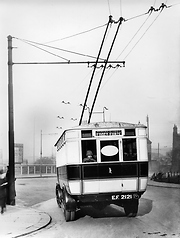 Donated by Douglas Ferriday
Donated by Douglas FerridayPart of the Hartlepool Library Service collection
Dated 1924
Two young children peer out of the rear windows of trolley bus EF 2121, as it enters Church Square from Upper Church Street, in 1924.
More detail » Laying of tram near Lord Clyde
Laying of tram near Lord Clyde
 Created by NDM
Donated by Hartlepool museum service
Created by NDM
Donated by Hartlepool museum serviceThe image shows the complicated process of laying tram tracks between Hartlepool and West Hartlepool, here outside the Lord Clyde Around 1884.
The photo was reproduced in Hartlepool Mail July 1963.
More detail » Leyland Lynx Tower Wagon
Leyland Lynx Tower Wagon
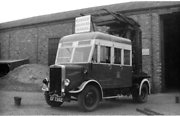 Created by unknown
Donated by Mr. John Watson
Created by unknown
Donated by Mr. John WatsonPart of the Eric Old collection
A Leyland Lynx Tower Wagon (EF 7352), purchased in 1940. It is seen here in the yard of the Greenland depot with wartime white edging to the mudguards and a hooded headlamp.
More detail » Mobile Electric Tram Scaffold
Mobile Electric Tram Scaffold
 Donated by Hartlepool Museum Service
Donated by Hartlepool Museum ServiceScaffold and ladder on cart used for repair. Owned by the Hartlepool Electric Tramway Company.
More detail » Musgrave Street/ Lynn Street corner
Musgrave Street/ Lynn Street corner
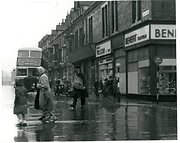 Donated by Hartlepool Museum Service
Donated by Hartlepool Museum ServicePart of the Hartlepool Museum Service collection
Taken on a rainy day in the late 1950s, the image shows a No.4 Corporation bus which would turn along into Lynn Street and finally weave its way to Thornhill Gardens (as on destination board), having come from Rift House.
The Benefit Shoe shop is on the corner of Lynn Street and into Musgrave Street is Ernest Wilson, Charles Dickens Tool Store and The Piccadilly Bar. Charles Dickens was one of the last buildings in the area to be finally demolished in 1978 and was the last to trade in the area.
More detail » North Eastern railway bus
North Eastern railway bus
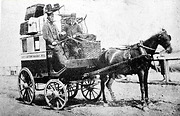 Created by James Whitehead Pattison
Donated by Bowes Museum, Barnard Castle, County Durham
Created by James Whitehead Pattison
Donated by Bowes Museum, Barnard Castle, County DurhamPart of the Pattison's Photographs collection
Dated 1888
The old North Eastern Railway bus would have transported passengers and their luggage to their accommodation in Seaton Carew.
More detail » Northern bus
Northern bus
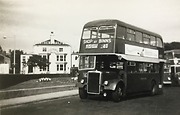
The Northern bus company livery was a maroon red colour. The company was founded in 1913 and ceased operation in 1967. Buses ran from West Hartlepool to Newcastle through Sunderland and Eadt Boldon.
This image probably from the early 1960s shows the Northern Daily Mail office in Clarence Road very clearly.
More detail » Number 5 Middlegate Bus
Number 5 Middlegate Bus
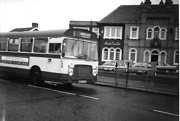 Donated by John Parsons
Donated by John ParsonsNumber 5 Middlegate Bus driving past the Brus Arms in Winterbottom Road possibly around 1998.
More detail » Old Hartlepool Blue Bus
Old Hartlepool Blue Bus
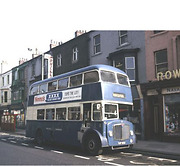 Donated by Mr. Bobby Black
Donated by Mr. Bobby BlackWhen old Hartlepool received Borough status, the Council purchased four second-hand double-deck buses. Painted blue, many local people would refuse to use any of the 'red' buses, preferring instead to wait for one of their own. These blue buses were garaged and maintained at the Bee Line coach garage in Oxford Road, West Hartlepool. The last blue bus ran on 28th April, 1967.
More detail » Omnibus in Blakelock Road
Omnibus in Blakelock Road
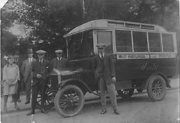 Donated by Hartlepool Museum Service
Donated by Hartlepool Museum ServiceA Ford T omnibus reg no. 2080. The vehicle is parked in Blakelock Road from which the service operated.
More detail » Overturned bus in snow
Overturned bus in snow
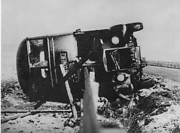 Donated by Hartlepool Museum Service
Donated by Hartlepool Museum ServiceDated 1945
The double-decker, carrying 72 passengers, was travelling from West Hartlepool to Port Clarence when the bus went out of control near Seaton Carew. The bus ended up on its side in a field which was 6 feet below road level. One man, Charles William Taylor of Middlesbrough, was killed and a woman, Doreen Makin of West Hartlepool, suffered chest injuries.
More detail » Park Road Stockton Street junction
Park Road Stockton Street junction
 Part of the Library collection collection
Part of the Library collection collectionProbably taken in the late 1950s, the image shows buses passing outside the Central Stores. This for many years was the bus route through Musgrave St, Lynn St and Church Street between Rift House and Hart Avenue/ Thornhill Gardens. Pierce Opticians is clearly visible in the cenre on Stockton St and the hoarding on the left advertises Halfords.
More detail » Putting up tram wires
Putting up tram wires
 Created by unknown
Donated by Hartlepool Museum Service
Created by unknown
Donated by Hartlepool Museum ServicePart of the Hartlepool Museum Service collection
Dated 1896
Like other tramway operators, the Hartlepool Electric Tramways Co. needed a tower wagon to permit work on the overhead wiring. An example is seen here in a deserted Church Street – possibly on a Sunday morning before the start of service. A horse was stabled at the Greenland depot to draw the tower wagon and for other purposes. Christ Church can be seen in the centre of the image. On the right a new National Provincial bank is under construction, the old one having been demolished on the same site.
More detail » Raby Road
Raby Road
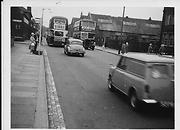 Donated by Hartlepool Library Service
Donated by Hartlepool Library ServicePart of the Library collection collection
A view probably taken in the early 1960s. On the right is the corner of the Chester Hotel and next to it behind the bus is Gales garage where cars were repaired and serviced. The building on the corner of Wharton Terrace on the left was Walker Ltd confectioners. Two West Hartlepool Corporation buses are passing and the one coming towards the camera is the number 4 going to Hart Lane from Rift House.
HHT&N 933
More detail » Railway bridge - 1896
Railway bridge - 1896
 Donated by Hartlepool Museum Service
Donated by Hartlepool Museum ServiceDated 1896
The bridge was near the Greenland tram depot. Note the boy knife grinder with his cart at right.
More detail » Red and blue corporation buses
Red and blue corporation buses
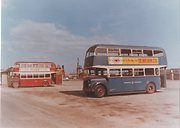 Donated by Hartlepool Museum Service
Donated by Hartlepool Museum ServiceTwo buses parked at George Street/ Mainsforth Terrace. Railway bridge signal gantry and Dock Office can be seen in the background. probably mid 1960s.
The red bus has the livery of West Hartlepool Corporation and the blue of Hartlepool Corporation Transport.
More detail » Rift House to Thornhill Gardens
Rift House to Thornhill Gardens
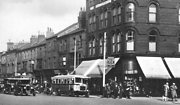 Created by unknown
Donated by Mr. John Watson
Created by unknown
Donated by Mr. John WatsonA motor bus service was started in the late 1920s from Rift House to Thornhill Gardens via the centre of West Hartlepool. This view shows one of the buses on that route in Church Street, passing Hill Carter’s store on its way to Thornhill Gardens. A large sign indicates the starting point for the Seaton Carew trolleybuses in Whitby Street.
More detail » Robert Rose, Tram Driver
Robert Rose, Tram Driver
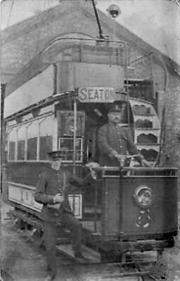 Donated by Maureen Anderson
Donated by Maureen AndersonMr Robert Rose, standing proudly in his smart uniform as he drives the tram from West Hartlepool to Seaton Carew.
More detail » Seaton Bus Station 1950s
Seaton Bus Station 1950s
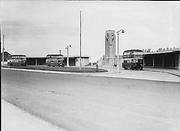 Part of the Hartlepool Library Collection collection
Part of the Hartlepool Library Collection collectionProbably taken in the early 1950s or before, the image shows three seemingly unoccupied buses the first with the destination West Hartlepool. Adverts are Binns, Typhoo Tea, Sparks and Andrews Liver Salts. The bus station opened in 1938.
HHT&N 135
More detail » Seaton Carew then and now
Seaton Carew then and now
 Created by Bill Stevenson
Donated by Hartlepool Library Service
Created by Bill Stevenson
Donated by Hartlepool Library ServiceSeaton Carew, Hartlepool. Stationary corporation bus going to West Hartlepool outside of what is now the Norton Hotel
More detail » Silver Jubilee Bus
Silver Jubilee Bus
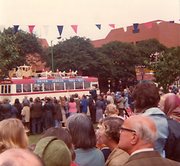 Created by Maureen Ledington
Donated by Maureen Ledington
Created by Maureen Ledington
Donated by Maureen LedingtonDated 1977
A special bus commemorating the Queen's Silver Jubilee passes the Civic Centre in Victoria Road.
More detail » Silver Jubilee Bus
Silver Jubilee Bus
 Donated by Hartlepool Museum Service
Donated by Hartlepool Museum ServiceDated 1977
Hartlepool Transport single decker bus painted silver to mark the Silver Jubilee 1952-1977.
More detail » Star Hotel, Lynn St
Star Hotel, Lynn St
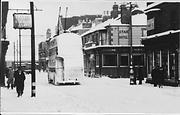 Donated by Douglas Ferriday
Donated by Douglas FerridayPart of the Library collection
A wintry scene in Lynn Street looking towards Church Street as a trolley bus makes its way through the snow. As the pub closed in 1942, the photo must have been taken before then.
HHT&N 20
More detail » Steam tram in Church Square
Steam tram in Church Square
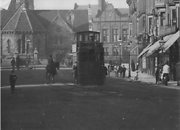 Donated by Hartlepool Museum Service
Donated by Hartlepool Museum ServiceChurch Street from seaward showing a steam tram in Church Square. This tram service was short lived
More detail » Syro change machine
Syro change machine
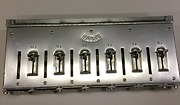 Donated by Hartlepool Museum Service
Donated by Hartlepool Museum ServiceThe change machine was introduced for use in the one man buses where there was no conductor.
More detail » TMS double decker bus
TMS double decker bus
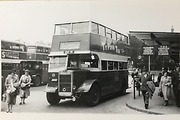 Created by East Pennine Transport Group
Created by East Pennine Transport Group
TMS was Trimdon Motor Services which ran successfully for many, many years, finally finishing in 2010 although services to Hartlepool ceased before then.
This photo was probably taken in the late 1950s in the bus station and looking towards Clarence Road. This bus is going to Sedgefield and the destination board on the bus stand shows the Trimdon, Kelloe, Coxhoe and Durham.
There are two ' clippies’ or bus conductresses on the left.
TMS livery was blue.
More detail » TMS single deck bus
TMS single deck bus
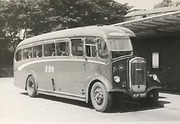
Probably 1950s, the bus is waiting at the TMS stand in West Hartlepool bus station. It was the one closest to Clarence Road.
More detail » Throston Bridge 1965
Throston Bridge 1965
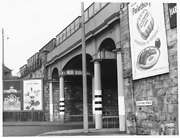 Donated by Douglas Ferriday
Donated by Douglas FerridayPart of the Hartlepool Library Services collection
Dated 1965
A side view of the entrance to Throston Bridge taken in 1965. Advertising hoardings are on the walls either side of the bridge.
More detail » Ticket from Ticket issuing machine
Ticket from Ticket issuing machine
 Donated by John Watson
Donated by John Watson Dated 2017
This is an example ticket from the ticket issuing machine which was used throughout the 1950s by West Hartlepool Corporation Transport. The tiny bit of paper gave a lot of information, the date, the route used, the fare stage where the passenger boarded and the amount paid.
The machine is shown on these pages as the one with a dial on it.
More detail » Ticket machine, one of 112
Ticket machine, one of 112
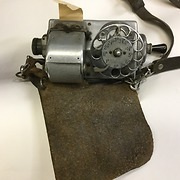 Donated by Hartlepool Museum Service
Donated by Hartlepool Museum ServiceIn 1947, West Hartlepool Transport introduced TIM, the ticket issuing machine, and after a successful trial further machines were purchased in 1951 and these were familiar with anyone travelling on West Hartlepool buses until 1961. The conductor would 'dial' a price depending on the journey, turn the handle and a paper ticket would come from the machine. The ticket indicated which stage the customer joined the bus, the price paid and the date.
This replaced the system whereby the conductor would carry a supply of different tickets and a punch.
More detail » Tower Wagon - 1929
Tower Wagon - 1929
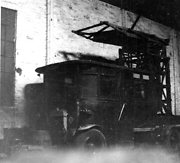 Created by unknown
Donated by Mr. John Watson
Created by unknown
Donated by Mr. John WatsonPart of the Eric Old collection
In 1925 the West Hartlepool Corporation motor bus fleet was expanded by the addition of four Bristol 2-ton vehicles with Bristol 24-seat bodies. There are no known photographs of these buses, but No. 10 (EF 2810) was converted to a tower wagon in 1929 and is seen here in that form nearly two decades later parked inside the depot.
More detail » Tram No 9 - 1903
Tram No 9 - 1903
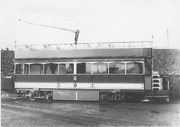 Donated by Hartlepool Museum Service
Donated by Hartlepool Museum ServiceThis vehicle was made from the bodies of two coaches, Nos. 1 & 4, joined together.
More detail » Tram Shed
Tram Shed
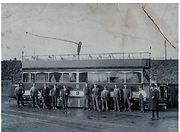 Donated by Dru Trenholm
Donated by Dru TrenholmDated 1909
This photograph is of the Tram Shed on Cleveland Road. We believe Victor Armstrong Trenholm is 3rd from the right.
His occupation was a Blacksmith's Striker.
More detail » Tram celebration
Tram celebration
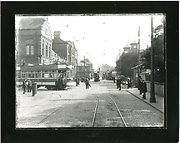 Donated by Douglas Ferriday
Donated by Douglas FerridayPart of the Hartlepool Library Service collection
Dated 1902
1902 A note of the back of photo says that it was to celebrate single to double tram line conversion. On the left are the municipal buildings and old central library, the clock tower of Gray Peverell (later Binns and Wilkinsons) is on the right and the man in the centre is probably transport manager or inspector. Trams from all corners and people appear to be conveniently posed !
More detail » Tram in Stranton
Tram in Stranton
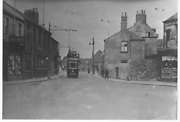 Donated by Douglas Ferriday
Donated by Douglas FerridayPart of the Hartlepool Library Service collection
Picture of a tram coming through Stranton. Date not known. The Causeway can be seen on the left.
More detail » Tramcar No.1
Tramcar No.1
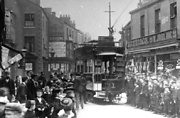 Donated by John Watson
Donated by John WatsonDated 1896
This photograph, taken in Northgate, Hartlepool, on the opening day, 19 May 1896, shows electric car No. 1, one of five 44-seat four-wheelers built by Milnes of Birkenhead for the new operating company, the General Electric Tramways Co. Ltd. (GET). The livery is thought to have been green and white.
HHT&N 87
More detail » Tramcar No.10
Tramcar No.10
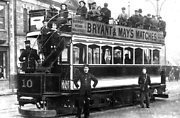 Donated by John Watson
Donated by John WatsonDated 1898
Car No.10, at the top of Church Street, West Hartlepool, in about 1898. This car seated 62 people and is fitted with a buffer and chains for the attachment of a trailer. The building partly obscured by the car is the Central Hall, which was replaced in 1901 by the four-storey Central Buildings, which was later to include the Devon Grill.
HHT&N 652
More detail » Tramcar No.11
Tramcar No.11
 Created by Valentine
Donated by John Watson
Created by Valentine
Donated by John WatsonDated 1899
This photograph, taken at the eastern end of Victoria Road, West Hartlepool, in 1899, shows one of the first five new cars (Nos. 11-15), of the Hartlepools Electric Tramcar Co. Ltd. (a subsidiary of the British Electric Tram Co. Ltd.). They were painted in the current standard BET livery of orange-yellow and white. In the background, the Wesley Chapel dominates the scene but the construction of the Grand Hotel behind it has not yet begun.
More detail » Tramcar No.19
Tramcar No.19
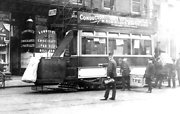 Created by unknown
Donated by John Watson
Created by unknown
Donated by John WatsonPart of the Andrew Milburn collection
Dated 1907
A posed view of the Hartlepool Electric Tram Company car No.19, taken around 1907 in Victoria Road, demonstrating the operation of the Tramways Parcels Express. Harrison’s Café and Creamery was one of a number of parcels agents appointed in local shops, and the building seen here eventually became part of Binns’ store. Third left in the group is Andrew Milburn, a parcels delivery boy, who was to spend his entire career with the local transport undertaking.
HHT&N 653
More detail » Tramcar No.20
Tramcar No.20
 Created by Reliable Series
Donated by John Watson
Created by Reliable Series
Donated by John WatsonThis postcard view shows one of the Hartlepool Electric Tram Company's two Brush 65-seat tramcars (either No. 20 or 21), in Church Street, West Hartlepool, in the early years of the 20th century. The ornate design of the centre poles is thought to have been unique to West Hartlepool.
More detail » Tramcar No.23
Tramcar No.23
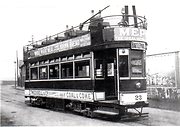 Created by unknown
Donated by Mr. John Watson
Created by unknown
Donated by Mr. John WatsonPart of the Hartlepool Transport Ltd. collection
Tramcar No. 23 outside the Greenland Depot. One of four such 70-seat bogie cars, the enclosed platforms were a welcome innovation, especially from the point of view of the drivers. They were mainly used on the Hartlepool line. (Hartlepool Transport Ltd collection)
HHT&N 654
More detail » Tramcar No.9
Tramcar No.9
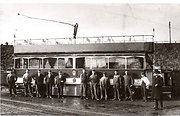 Created by unknown
Donated by Mr. John Watson
Created by unknown
Donated by Mr. John WatsonDated 1904
Tramcar No.9, one of a unique pair of cars (No.8 being the other), constucted by the Greenland depot workshop staff in 1904. These two 84-seat cars are thought to have been the largest to have operated on a British 3ft 6in gauge tramway. The gentleman at the right is believed to be the manager at that time, William H Bettison.
HHT&N 655
More detail » Trolley Buses in Church Square
Trolley Buses in Church Square
 Created by unknown
Donated by Hartlepool Library Service
Created by unknown
Donated by Hartlepool Library ServiceA wartime photograph of trolley buses in Church Square. At the top of the picture is the large static water tank '32', and the Devon Grill on the left.
More detail » Trolley bus Depot
Trolley bus Depot
 Donated by Hartlepool Library Service
Donated by Hartlepool Library ServiceThe West Hartlepool trolley bus depot, Cleveland Road, in 1928. The billboards are advertising local elections, sporting events and a 1920s "X-factor" competition run by the Northern Echo!
More detail » Trolley bus Depot and Offices
Trolley bus Depot and Offices
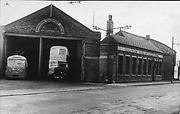 Donated by Hartlepool Library Service
Donated by Hartlepool Library ServiceThe trolley bus depot in Cleveland Road, showing the addition of the Tram Office. This building, originally dating from 1900, was eventually rescued and rebuilt within the grounds of the former Hartlepool Museum & Art Gallery at Sir William Gray House, where it is in use as a Community Workshop.
HHT&N 636
More detail » Trolley buses 1927
Trolley buses 1927
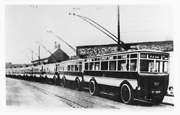 Donated by Douglas Ferriday
Donated by Douglas FerridayPart of the Hartlepool Library Service collection
Trolley buses from 1927 lined up outside the tram sheds on Cleveland Road
More detail » United Bus
United Bus
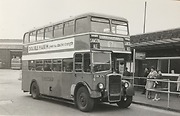 Created by East Pennine Transport Groupb
Created by East Pennine Transport Groupb
Taken in the bus station with Clarence Road in the background is a United (BBL?) decker ready for the old Hartlepool Service.
More detail »
 United Bus mid 1960s
United Bus mid 1960s
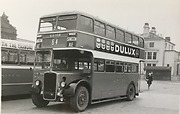 Created by East Pennine Transport Group
Created by East Pennine Transport Group
Taken in West Hartlepool bus station around 1966, is one of many United buses which went in and out of the bus station. Behind is Clarence Road and the old Northern Daily Mail office.
The livery of United buses was a scarlet red.
More detail » United Old Folks Trip (sic)
United Old Folks Trip (sic)
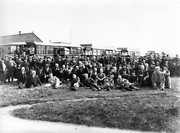 Donated by Hartlepool Library Service
Donated by Hartlepool Library ServiceUnited Buses Old Folks Trip. Passengers posing outside of the buses ready for the off.
HHT&N 685
More detail » Unloading goods from tram in Victoria Road
Unloading goods from tram in Victoria Road
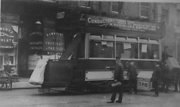 Donated by Hartlepool Museum Service
Donated by Hartlepool Museum ServicePart of the A. Milburn collection
The confectioners was the central parcel agent (c1905). Under direction the boys are unloading a large basket and a box from the tram. The boy on the right of the basket is Andrew Milburn
More detail » Upper Church Street 1946
Upper Church Street 1946
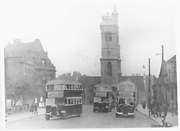 Donated by Douglas Ferriday
Donated by Douglas FerridayPart of the Hartlepool Library Services collection
A busy view of upper Church Street with Christ Church in the background.
More detail » Victoria Road 1988
Victoria Road 1988
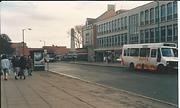 Part of the Hartlepool Library collection
Part of the Hartlepool Library collectionDated 1988
In 1988, Perry's TV shop is clearly visible on the corner of Victory Square. A 'Hartlepool Hoppa' bus is on the left.
HHT&N 214
More detail » WHC No.1 - 1950
WHC No.1 - 1950
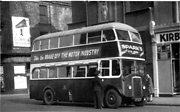 Created by unknown
Donated by Mr. John Watson
Created by unknown
Donated by Mr. John WatsonPart of the W.J. Haynes collection
Four more centre-entrance Daimler/Roe double-deck motor buses entered West hartlepool Corporation service in 1938. Seen here is No. 1 (EF 6721) at the Church Street starting point in about 1950. Kirby’s was one of only a small number of cafés in the Hartlepools at this time.
More detail » WHC Motor Bus No.14
WHC Motor Bus No.14
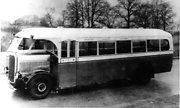 Created by unknown
Donated by Mr. John Watson
Created by unknown
Donated by Mr. John WatsonPart of the Hartlepool Transport Ltd. collection
Dated 1935
Two Bristol J types with Bristol 36-seat single-deck bodies were purchased in 1935. Seen here at the builder’s premises is No. 14 (EF 5634). No photographs are known of these vehicles in service.
More detail » WHC Motor Bus No.19 - 1950s
WHC Motor Bus No.19 - 1950s
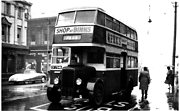 Created by unknown
Donated by Mr. John Watson
Created by unknown
Donated by Mr. John WatsonPart of the John Fozard collection
Corporation bus No. 19 (EF 7946) is shown in Church Street in the 1950s on arrival from the Park. A rare Austin A90 Atlantic car is parked alongside the Shades Hotel. (John Fozard)
More detail »
 WHC Motor Bus No.26
WHC Motor Bus No.26
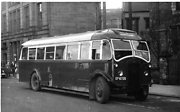 Created by unknown
Donated by Mr. John Watson
Created by unknown
Donated by Mr. John WatsonPart of the Alan B. Cross collection
Dated 1951
West hartlepool Corporation single-deck bus No.26 (EF 6726), shown here in Church Square in 1951 on the Park circular service which had started in 1948. At the right is Christ Church vicarage, which was demolished in 1960. (Alan B Cross)
More detail » WHC Motor Bus No.29
WHC Motor Bus No.29
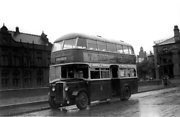 Created by unknown
Donated by Mr. John Watson
Created by unknown
Donated by Mr. John WatsonPart of the Roy Marshall collection
Dated 1949
This photograph is of No. 29 (EF 7029) parked in the United Bus Station, West Hartlepool, in about 1949.
More detail » WHC Motor Bus No.3
WHC Motor Bus No.3
 Created by unknown
Donated by Mr. John Watson
Created by unknown
Donated by Mr. John WatsonPart of the John D. Watson collection
Dated 1926
Two Bristol 4-ton vehicles with Bristol 30-seat bodies were added to the West Hartlepool Corporation motor bus fleet in 1926. No. 3 (EF 3253) is seen here when new, posed at The Green, Seaton Carew. Pneumatic tyres were becoming standard by this time for all but the largest vehicles. (John D Watson collection)
More detail » WHC Motor Bus No.35 - 1950s
WHC Motor Bus No.35 - 1950s
 Created by unknown
Donated by Mr. John Watson
Created by unknown
Donated by Mr. John WatsonPart of the East Pennine Transport Group collection
In the early years of the Second War, bus operators had little choice of vehicle, and generally had to accept whatever was available. In 1942 the Corporation received two Roe centre-entrance bodies originally intended for Sunderland Corporation and mounted on AEC Regent chassis. This photograph shows No. 35 (EF 7379) standing in Church Street in the 1950s.
More detail » WHC Motor Bus No.36 - 1953
WHC Motor Bus No.36 - 1953
 Created by unknown
Donated by Mr. John Watson
Created by unknown
Donated by Mr. John WatsonPart of the Alan B. Cross collection
Dated 1953
West Hartlepool Corporation bus No.36 (EF 7380), parked in West Hartlepool bus station in July 1953, with the destination blind set for a journey to the South Durham steelworks. This vehicle is now preserved in private ownership.
More detail » WHC Motor Bus No.39 - 1942
WHC Motor Bus No.39 - 1942
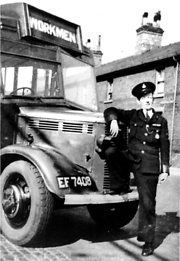 Created by unknown
Donated by Mr. John Watson
Created by unknown
Donated by Mr. John WatsonPart of the J. Pearson collection
Dated 1942
The standard wartime single-deck vehicle was the petrol-engined Bedford OWB, and West Hartlepool took two of them in 1942, with SMT 32-seat bodies, but kept them for only five years. No. 39 (EF 7408) is shown here outside the Corporation Depot. The driver is wearing the standard uniform of the time.
More detail » WHC Motor Bus No.4
WHC Motor Bus No.4
 Created by unknown
Donated by Mr. John Watson
Created by unknown
Donated by Mr. John WatsonPart of the Eric Old collection
This is the only known photograph of any of the five 32-seat single deck motor buses purchased by West Hartlepool Corporation in 1920. This is No. 4 (EF 1153), at the Seaton Carew terminus in the early 1920s. The driver’s leather leggings are an interesting feature of his uniform.
More detail » WHC Motor Bus No.44 - 1950s
WHC Motor Bus No.44 - 1950s
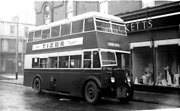 Created by unknown
Donated by Mr. John Watson
Created by unknown
Donated by Mr. John WatsonPart of the East Pennine Transport Group collection
Corporation bus No. 44 (EF 7483), outside Blackett’s (formerly Hill Carter’s) in Whitby Street, bound for Seaton Carew, sometime in the 1950s.
More detail » WHC Motor Bus No.45 - 1953
WHC Motor Bus No.45 - 1953
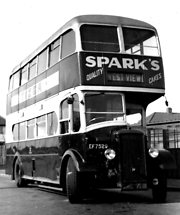 Created by unknown
Donated by Mr. John Watson
Created by unknown
Donated by Mr. John WatsonPart of the David Burnicle collection
Dated 1953
West Hartlepool Corporation bus No.45 (EF 7529), seen here in 1953 at the Oxford Road terminus of the service to West View. In the mid-1950s this bus was used mainly on the Church Square-Catcote Road service running along the unsuitable Ardrossan Road until the construction of Rossmere Way was completed.
More detail »
 WHC Motor Bus No.48 - 1960
WHC Motor Bus No.48 - 1960
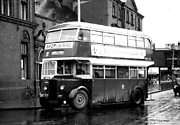 Created by unknown
Donated by Mr. John Watson
Created by unknown
Donated by Mr. John WatsonPart of the Robert F. Mack collection
Corporation bus No. 48 (EF 8282) is seen here rounding the library corner in West Hartlepool on a wet day about 1960. By this time bus roofs were being painted red instead of grey and the fleet had been fitted with boxes displaying service numbers.
More detail » WHC Motor Bus No.55
WHC Motor Bus No.55
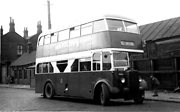 Created by unknown
Donated by Mr. John Watson
Created by unknown
Donated by Mr. John WatsonPart of the W.J. Haynes collection
This photograph is of No. 55 (EF 8289) at the Port Clarence side of the Middlesbrough Transporter Bridge in the early 1950s.
More detail » WHC Motor Bus No.56 - 1964
WHC Motor Bus No.56 - 1964
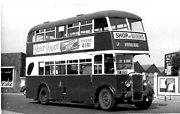 Created by unknown
Donated by Mr. John Watson
Created by unknown
Donated by Mr. John WatsonPart of the D.D. Kirk collection
Dated 1964
Corporation bus No.56 (EF *%%*), was the first of nine double-deck buses with a rear entrance and was exhibited at the Commercial Motor Transport Exhibition in London in November 1948. Non-standard features comprised gold lining, red mudguards and a chromium-plated radiator shell, although by 1964 when this photograph was taken in Church Square, only the last-mentioned survived.
More detail » WHC Motor Bus No.60 - 1950s
WHC Motor Bus No.60 - 1950s
 Created by unknown
Donated by Mr. John Watson
Created by unknown
Donated by Mr. John WatsonPart of the Robert F. Mack collection
Corporation bus No.60 (EF 8997) is seen here in the 1950s at the Owton Manor Lane terminus in Stockton Road. St Teresa’s Church is at the left in this scene.
More detail » WHC Motor Bus No.75 - 1960
WHC Motor Bus No.75 - 1960
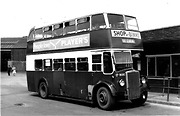 Created by unknown
Donated by Mr. John Watson
Created by unknown
Donated by Mr. John WatsonPart of the G. Mead collection
Dated 1960
Corporation bus No. 75 (EF 9595) is seen in 1960 about to depart for Port Clarence from the United bus station. (G Mead)
More detail » WHC Motor Bus No.8
WHC Motor Bus No.8
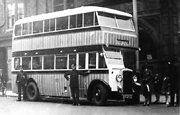 Created by unknown
Donated by Mr. John Watson
Created by unknown
Donated by Mr. John WatsonPart of the Hartlepool Transport Ltd collection
One of West Hartlepool Corporation's first double-deck motor buses, placed in service in 1931. The main panels of these vehicles were of aluminium, unpainted and buffed to produce an attractive striped effect. This view shows No. 8 (EF 4738) bound for Rift House, outside the Yorkshire Penny Bank in Church Street.
More detail » WHC Motor Bus No.93 - 1975
WHC Motor Bus No.93 - 1975
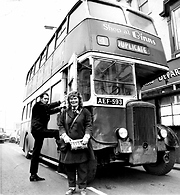 Created by Northern Daily Mail
Donated by Northern Daily Mail
Created by Northern Daily Mail
Donated by Northern Daily MailDated 1975
Corporation bus No.93 (AEF 593), in Church Street on its last day in service, 28th February, 1975, with driver Vince Dunning and conductress Diane Davey. The vehicle had covered nearly 750,000 miles. The conductress is equipped with the standard ticket machine of the time, the six-value “Ultimate”, which issued small square tickets in various colours.
More detail »
 WHC Tramcar No.2
WHC Tramcar No.2
 Created by unknown
Donated by Mr. John Watson
Created by unknown
Donated by Mr. John WatsonThe West Hartlepool Corporation Tramcar No.2, one of five, new 58-seat cars purchased in 1914. In this photograph the tram is passing the Causeway Inn at Stranton, on the Foggy Furze line, probably in the early 1920s. The corporation’s livery was a brownish dark red and white.
HHT&N 656
More detail » WHC Tramcar No.30
WHC Tramcar No.30
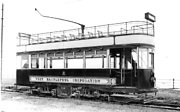 Created by unknown
Donated by Leicestershire Museums, Art Galleries and Records Service
Created by unknown
Donated by Leicestershire Museums, Art Galleries and Records ServiceDated 1920
West Hartlepool Corporation purchased six tramcars in 1920 to replace some of the original cars on the system, which had been worked hard during the First World War. Here, No. 30 is posed when new on the Seaton Carew line close to Newburn Bridge.
HHT&N 657
More detail » WHC Tramcar No.8
WHC Tramcar No.8
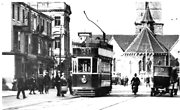 Created by unknown
Donated by Mr. John Watson
Created by unknown
Donated by Mr. John WatsonPart of the Tramway Museum Society collection
Dated 1926
West Hartlepool Corporation's 66-seat tramcar No. 8, seen here in about 1926 picking up passengers at the western end of Church Street. Other points of interest in this scene are the taxi rank on the north side of the street, a motorcyclist wearing a trilby hat, and a small bus standing next to Christ Church, possibly on one of the privately operated services running to points in east Durham.
More detail » WHC Trolleybus No.1
WHC Trolleybus No.1
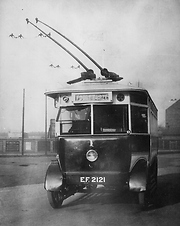 Created by unknown
Donated by Hartlepool Library Service
Created by unknown
Donated by Hartlepool Library ServiceDated 1927
West Hartlepool Corporation trolleybus No.1 in Church Square, 1927.
More detail » WHC Trolleybus No.22
WHC Trolleybus No.22
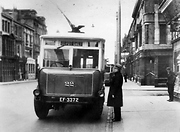 Created by unknown
Donated by Hartlepool Library Service
Created by unknown
Donated by Hartlepool Library ServiceDated 1935
West Hartlepool Corporation trolley bus No.22 in Church Square, sometime around 1935.
More detail » WHC Trolleybus No.3
WHC Trolleybus No.3
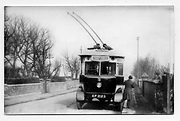 Created by unknown
Donated by Hartlepool Library Service
Created by unknown
Donated by Hartlepool Library ServiceDated 1924
West Hartlepool Corporation trolley bus No.3 on Stockton Road, near Tanfield Road, around 1924.
More detail » WHC Trolleybus No.3
WHC Trolleybus No.3
 Created by unknown
Donated by Mr. John Watson
Created by unknown
Donated by Mr. John WatsonPart of the Hartlepool Transport Ltd. collection
West Hartlepool Corporation's 36-seat Trolleybus No. 3 (EF 2123), on the extension to the Foggy Furze route, near to the Traveller's Rest Hotel. Also shown is the corporation’s motor tower wagon, LH 8216, which had been converted from a London General AEC motor bus new in 1914.
More detail » WHC Trolleybus No.34 - 1952
WHC Trolleybus No.34 - 1952
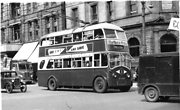 Created by unknown
Donated by Mr. John Watson
Created by unknown
Donated by Mr. John WatsonPart of the East Pennine Transport Group collection
Dated 1952
Towards the end of 1938, eight Daimler/Roe double-deck trolleybuses replaced the earlier vehicles operated jointly by the Hartlepool and West hartlepool Corporations on the Hartlepool route. This view shows No. 34 (EF 6894) in Church Street about 1952.
More detail » WHC Trolleybus No.4
WHC Trolleybus No.4
 Created by unknown
Donated by Hartlepool Library Service
Created by unknown
Donated by Hartlepool Library ServiceDated 1924
The 1924 West Hartlepool Corporation trolley bus No.4 turning round on Belle Vue Way/Loyalty Road.
More detail » WHC Trolleybus No.5
WHC Trolleybus No.5
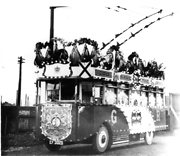 Created by unknown
Donated by Mr. John Watson
Created by unknown
Donated by Mr. John WatsonPart of the Hartlepool Transport Ltd. collection
West Hartlepool Corporation Trolleybus No. 5 (EF 3025) in 1937 on the Park route, not long before withdrawal, illuminated and decorated to celebrate the coronation of King George VI.
More detail » WHC Trolleybus No.5 - 1950
WHC Trolleybus No.5 - 1950
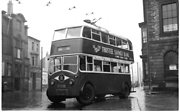 Created by unknown
Donated by Mr. John Watson
Created by unknown
Donated by Mr. John WatsonPart of the C. Carter collection
In 1938 West Hartlepool Corporation made a start to renew their trolleybus fleet. First of all, six Daimler double-deckers with Roe 54-seat bodies entered service, mainly on the Park and Foggy Furze routes. No. 5 (EF 6705) is seen here in the early 1950s negotiating the turning circle at the foot of Church Street.
More detail » WHC Trolleybus No.7
WHC Trolleybus No.7
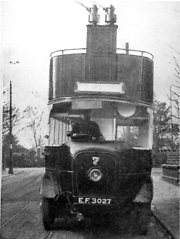 Created by unknown
Donated by Mr. John Watson
Created by unknown
Donated by Mr. John WatsonPart of the John D. Watson collection
West Hartlepool Corporation Trolleybus No.7 at the Park route terminus. This 48-seat open-top double-deck vehicle proved to be unsatisfactory, already being of obsolete design when new, and last ran in 1928.
More detail » WHC Trolleybus No.8
WHC Trolleybus No.8
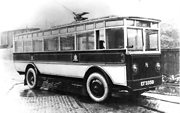 Created by unknown
Donated by Mr. John Watson
Created by unknown
Donated by Mr. John WatsonPart of the Roy Marshall collection
Trolleybus No.8 was one of a special batch in the joint ownership of the Hartlepool and West Hartlepool Corporations and wore both corporations' insignia. For the purposes of management and operation the new fleet was treated as a part of the West Hartlepool undertaking. No. 8 (EF 3358), is shown here outside the depot when new. The new service operated a one-way loop in Hartlepool, with a terminus near St Hilda’s Church about 300 yards beyond the former tram terminus in Northgate.
More detail » WHC Trolleybus No.8 - 1939
WHC Trolleybus No.8 - 1939
 Created by unknown
Donated by Mr. John Watson
Created by unknown
Donated by Mr. John WatsonPart of the Eric Old collection
Leyland trolleybus No.8 (EF 7038) frequently appeared on the Park service, but was otherwise used mainly on duplicate and workmen’s journeys. This photograph is of No. 8 (EF 7038) on such a journey which had terminated at Trinity Church, Hartlepool: the trolley arms are being re-wired after the vehicle had turned by gravity, making use of the favourable gradient at this point.
More detail » WHCT No.1
WHCT No.1
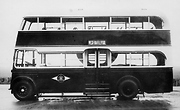 Created by unknown
Donated by Hartlepool Library Service
Created by unknown
Donated by Hartlepool Library ServiceDated 1937
The brand new West Hartlepool Corporation Trolleybus No.1 at Roe's, Leeds in 1937.
More detail » WHCT No.10
WHCT No.10
 Created by unknown
Donated by Hartlepool Library Service
Created by unknown
Donated by Hartlepool Library ServiceDated 1934
West Hartlepool Corporation No.10 at Roe's factory, Leeds, in 1934.
More detail » WHCT No.14
WHCT No.14
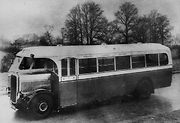 Created by unknown
Donated by Hartlepool Library Service
Created by unknown
Donated by Hartlepool Library ServiceWest Hartlepool Corporation single-decker No.14.
More detail » WHCT No.19
WHCT No.19
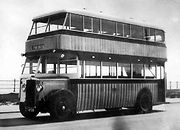 Created by unknown
Donated by Hartlepool Library Service
Created by unknown
Donated by Hartlepool Library ServiceDated 1931
West Hartlepool Corporation No.19 parked at Seaton Carew in 1931. Its polished panels give a 'zebra-stripe' look.
More detail » WHCT No.25
WHCT No.25
 Created by unknown
Donated by Hartlepool Library Service
Created by unknown
Donated by Hartlepool Library ServiceDated 1927
West Hartlepool Corporation trolley bus No.26 outside Roe's factory, Leeds, in 1927. This vehicle has a Garrett chasis.
More detail » WHCT No.25 (2)
WHCT No.25 (2)
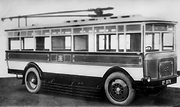 Created by unknown
Donated by Hartlepool Library Service
Created by unknown
Donated by Hartlepool Library ServiceDated 1927
A front quarter view of trolley bus No.25, taken in 1927.
More detail » WHCT No.26
WHCT No.26
 Created by unknown
Donated by Hartlepool Library Service
Created by unknown
Donated by Hartlepool Library ServiceDated 1938
The West Hartlepool Corporation single-deck No.26 (EF 6726), at Roe's factory, Leeds in 1938.
More detail » WHCT No.26
WHCT No.26
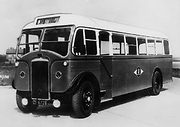 Created by unknown
Donated by Hartlepool Library Service
Created by unknown
Donated by Hartlepool Library ServiceDated 1938
West Hartlepool Corporation No.26 at the Roe's factory, Leeds, in 1938.
More detail » WHCT No.32
WHCT No.32
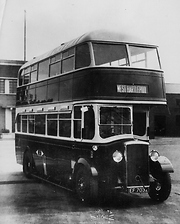 Created by unknown
Donated by Hartlepool Library Service
Created by unknown
Donated by Hartlepool Library ServiceDated 1939
West Hartlepool Corporation No.32 outside Roe's factory, Leeds, in 1939.
More detail » WHCT No.32 (side)
WHCT No.32 (side)
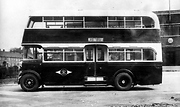 Created by unknown
Donated by Hartlepool Library Service
Created by unknown
Donated by Hartlepool Library ServiceDated 1939
West Hartlepool Corporation No.32 outside Roe's factory, Leeds, in 1939.
More detail » WHCT No.34
WHCT No.34
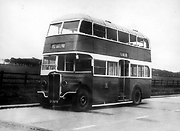 Created by unknown
Donated by Hartlepool Library Service
Created by unknown
Donated by Hartlepool Library ServiceDated 1942
The West Hartlepool Corporation bus No.34 (EF 7378), "parked and posed" on Brenda Road in 1942.
More detail » WHCT No.44
WHCT No.44
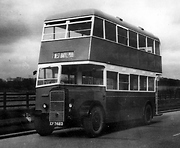 Created by unknown
Donated by Hartlepool Library Service
Created by unknown
Donated by Hartlepool Library ServiceDated 1945
West Hartlepool Corporation No.44 parked on Brenda Road in 1945.
More detail » WHCT No.53
WHCT No.53
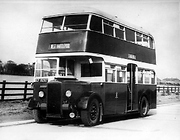 Created by unknown
Donated by Hartlepool Library Service
Created by unknown
Donated by Hartlepool Library ServiceDated 1948
West Hartlepool Corporation No.53 parked on Brenda Road in 1948.
More detail » WHCT No.56
WHCT No.56
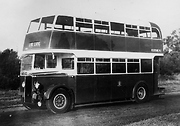 Created by unknown
Donated by Hartlepool Library Service
Created by unknown
Donated by Hartlepool Library ServiceDated 1948
A West Hartlepool Corporation 'Special' for the 1948 Commercial Motor Show in London. This vehicle had a chromed radiator, gold pinstriping, red mudguards and a special plate on the platform.
More detail » WHCT No.8
WHCT No.8
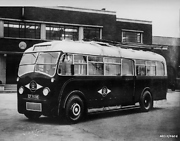 Donated by Hartlepool Library Service
Donated by Hartlepool Library ServiceA brand new West Hartlepool Corporation trolley bus (no.8) EF 7038 stands outside the Roe factory, which specialised in building coach bodies. This photograph was taken in 1939, just before the outbreak of the Second World War.
More detail » WHCT No.91
WHCT No.91
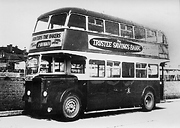 Created by unknown
Donated by Hartlepool Library Service
Created by unknown
Donated by Hartlepool Library ServiceDated 1960
West Hartlepool Corporation bus No.91 (AEF 591) parked on the Trading Estate circa 1960. In the background is the old General Hospital.
More detail » WHCT tram conductor
WHCT tram conductor
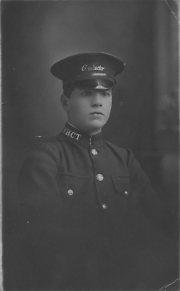 Created by Thirlwell
Donated by Hartlepool Museum Service
Created by Thirlwell
Donated by Hartlepool Museum ServiceA young man in tram conductor's uniform
More detail » Ward Jackson toppled
Ward Jackson toppled
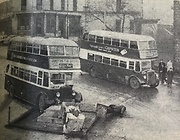 Created by NDM
Donated by Hartlepool museum service
Created by NDM
Donated by Hartlepool museum serviceDated 1956
In 1956, a corporation bus skidded in Church Street and caused the town's founder to topple from his perch. Nobody was hurt, the statue survived pretty much unscathed and was put back in place.
More detail » Wartime livery (1)
Wartime livery (1)
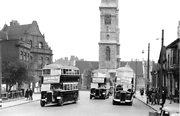 Created by unknown
Donated by Mr. John Watson
Created by unknown
Donated by Mr. John WatsonPart of the Hartlepool Transport Ltd. collection
West Hartlepool Corporation introduced a new fleet livery of Royal Dominion red and cream in 1934, the earlier striped livery having been found troublesome when panels became damaged. Roe-bodied Daimlers No.1 (EF6321), 7 and 10 (EF 5387 and 5390), are seen here posed in Upper Church Street in war-time. The hooded headlamps and white-tipped mudguards were to permit operation in black-out conditions, and bus roofs were now painted grey instead of cream to reduce visibility from above.
More detail » Wartime livery (2)
Wartime livery (2)
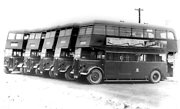 Created by unknown
Donated by Mr. John Watson
Created by unknown
Donated by Mr. John WatsonPart of the John D. Watson collection
Between 1942 and 1944, West Hartlepool Corporation purchased five double-deck buses fitted-out to "utility" specifications, which included 56 slatted wooden seats and a wartime grey-green livery.
More detail » West Hartlepool Corporation bus c1920
West Hartlepool Corporation bus c1920
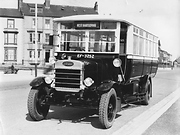 Donated by Douglas Ferriday
Donated by Douglas FerridayPart of the Hartlepool Library Service collection
West Hartlepool Corporation bus. Taken at The Front, Seaton Carew with what is now the Norton Hotel in the background.
More detail » West Hartlepool Trolley Bus
West Hartlepool Trolley Bus
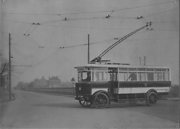 Donated by Hartlepool Museum Service
Donated by Hartlepool Museum ServiceSingle decker trolley bus at Foggy Furze turning round near old Traveller's Rest Public House. c1924
More detail »




